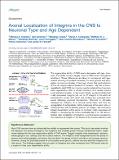Files in this item
Axonal localization of integrins in the CNS is neuronal type and age dependent
Item metadata
| dc.contributor.author | Andrews, Melissa Renee | |
| dc.contributor.author | Soleman, Sara | |
| dc.contributor.author | Cheah, Menghon | |
| dc.contributor.author | Tumbarello, David | |
| dc.contributor.author | Mason, Matthew | |
| dc.contributor.author | Moloney, Elizabeth | |
| dc.contributor.author | Verhaagen, Joost | |
| dc.contributor.author | Bensadoun, Jean-Charles | |
| dc.contributor.author | Schneider, Bernard | |
| dc.contributor.author | Aebischer, Patrick | |
| dc.contributor.author | Fawcett, James | |
| dc.date.accessioned | 2016-08-03T16:30:21Z | |
| dc.date.available | 2016-08-03T16:30:21Z | |
| dc.date.issued | 2016-07 | |
| dc.identifier | 244180179 | |
| dc.identifier | 06a8ffcc-7ac1-472a-812e-6d8780c47f9a | |
| dc.identifier | 85019538563 | |
| dc.identifier | 000391928700003 | |
| dc.identifier.citation | Andrews , M R , Soleman , S , Cheah , M , Tumbarello , D , Mason , M , Moloney , E , Verhaagen , J , Bensadoun , J-C , Schneider , B , Aebischer , P & Fawcett , J 2016 , ' Axonal localization of integrins in the CNS is neuronal type and age dependent ' , eNeuro , vol. 3 , no. 4 , e0029-16.2016 . https://doi.org/10.1523/ENEURO.0029-16.2016 | en |
| dc.identifier.issn | 2373-2822 | |
| dc.identifier.uri | https://hdl.handle.net/10023/9250 | |
| dc.description | This work was supported by the International Foundation for Research in Paraplegia (MRA), the Bryon Riesch Paralysis Foundation (MRA), the American Association of Anatomists (MRA), the Christopher and Dana Reeve Foundation (JWF), the Medical Research Council (JWF), the Plasticise European Network (seventh framework program) (JWF) and the NIHR Cambridge Biomedical Research Centre. | en |
| dc.description.abstract | The regenerative ability of CNS axons decreases with age however this ability remains largely intact in PNS axons throughout adulthood. These differences are likely to correspond with age-related silencing of proteins necessary for axon growth and elongation. In previous studies, it has been shown that reintroduction of the alpha9 integrin subunit (tenascin-C receptor, α9) that is downregulated in adult CNS can improve neurite outgrowth and sensory axon regeneration after a dorsal rhizotomy or a dorsal column crush spinal cord lesion. In the current study, we demonstrate that virally-expressed integrins (α9, α6, or β1 integrin) in the adult rat sensorimotor cortex and adult red nucleus are excluded from axons following neuronal transduction. Attempts to stimulate transport by inclusion of a cervical spinal injury and thus an upregulation of extracellular matrix molecules at the lesion site, or co-transduction with its binding partner, β1 integrin, did not induce integrin localization within axons. In contrast, virally-expressed α9 integrin in developing rat cortex (postnatal day 5 or 10) demonstrated clear localization of integrins in cortical axons revealed by the presence of integrin in the axons of the corpus callosum and internal capsule as well as in the neuronal cell body. Furthermore, examination of dorsal root ganglia neurons and retinal ganglion cells demonstrated integrin localization both within peripheral nerve as well as dorsal root axons and within optic nerve axons, respectively. Together, our results suggest a differential ability for in vivo axonal transport of transmembrane proteins dependent on neuronal age and subtype. | |
| dc.format.extent | 14 | |
| dc.format.extent | 5971938 | |
| dc.language.iso | eng | |
| dc.relation.ispartof | eNeuro | en |
| dc.subject | Adeno-associated virus | en |
| dc.subject | Axon | en |
| dc.subject | Axon initial segment | en |
| dc.subject | Dorsal root ganglia | en |
| dc.subject | Integrin | en |
| dc.subject | Lentivirus | en |
| dc.subject | Retinal ganglion-cells | en |
| dc.subject | Sensorimotor cortex | en |
| dc.subject | QH426 Genetics | en |
| dc.subject | RC0321 Neuroscience. Biological psychiatry. Neuropsychiatry | en |
| dc.subject | Neuroscience(all) | en |
| dc.subject | NDAS | en |
| dc.subject.lcc | QH426 | en |
| dc.subject.lcc | RC0321 | en |
| dc.title | Axonal localization of integrins in the CNS is neuronal type and age dependent | en |
| dc.type | Journal article | en |
| dc.contributor.institution | University of St Andrews. School of Medicine | en |
| dc.identifier.doi | 10.1523/ENEURO.0029-16.2016 | |
| dc.description.status | Peer reviewed | en |
This item appears in the following Collection(s)
Items in the St Andrews Research Repository are protected by copyright, with all rights reserved, unless otherwise indicated.

